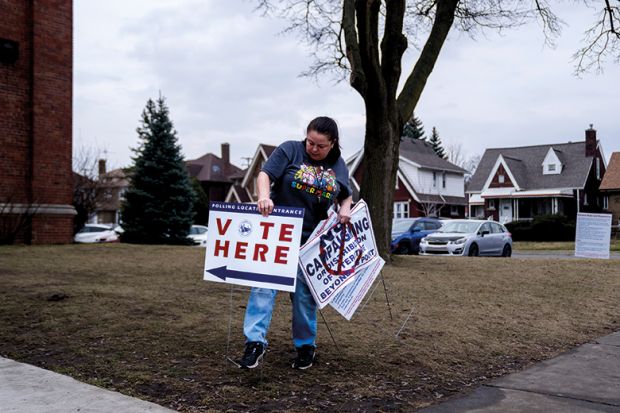After helping to produce a record jump in 2020 in the number of US university students voting, campus pro-democracy strategists are looking in 2024 to avoid a backslide, with a particular emphasis on politically uncooperative states and disadvantaged students and institutions.
Aided by sympathetic campus administrators and prodded by a high-anxiety presidential election, about 66 per cent of US college students voted in 2020, up from 52 per cent in 2016. That 14 percentage-point gain was double the overall increase in US voting and helped disrupt traditional ideas of students as more likely to protest than vote.
For this year, however, student voting advocates are setting their goal only slightly higher – 68 per cent – in recognition of the constant challenge of educating a new generation of college students, combined with rising political challenges in conservative-led states that are deliberately adding obstacles to youth voting.
“There has been a rash of state-level legislation, much of which has been aimed at college students, that has made it more difficult for college students to vote,” said Daniel Fersh, a spokesperson for the Students Learn Students Vote Coalition, which aids student voting efforts at more than 800 US colleges and universities.
Partisan interference in student voting is “worse, absolutely worse” this year compared with the 2020 election, said Jen Domagal-Goldman, the executive director of the ALL IN Campus Democracy Challenge, a coalition that has operations on about 980 US campuses.
Examples, Dr Domagal-Goldman said, included several states – including North Carolina, Ohio, Idaho, Missouri, North Dakota, South Carolina and Tennessee – that have limited the identifications acceptable to prove voter eligibility, typically in ways that reduce or eliminate the use of official campus IDs.
Student voting is also subject in many locations to ongoing battles over polling locations. Even New York state, which in 2022 required voting stations on or near larger campuses, is having trouble gaining wide-scale compliance for this year’s election.
The overall effort to boost student voting is getting some help from the Biden administration, which just issued a letter making clear to campus leaders that they can use federal work study funding – a programme that helps students pay for college through part-time employment – for jobs that involve non-partisan voter registration activities. That can involve something as small as a campus library worker handing out bookmarks with voter registration messages, or as involved as students working at election offices in their local communities, Dr Domagal-Goldman said.
While such uses of work-study money are allowed, institutions have often been wary of doing it, in part “because of the lack of explicit guidance” from the federal government, Mr Fersh said. The Biden administration has tried to address that in the past, issuing a similar advisory letter to campus leaders ahead of the 2022 mid-term elections, reminding them of their legal requirement to distribute voter education and registration materials.
The need is especially acute at institutions that serve minority and low-income students. At such places, including community colleges, the student voting rates ran significantly below the levels seen elsewhere, Mr Fersh said. Historically black colleges are especially vulnerable because they are often located in states where politicians have long tried to limit their participation in the democratic process.
Yet that region also has some important success stories, sometimes driven by just a single committed leader, Mr Fersh said. He cited the example of East Tennessee State University, an Appalachian campus of about 14,000 students, where the voting rate jumped from 47 per cent in 2016 to 64 per cent in 2020.
Primary credit for that success, Mr Fersh said, belonged to Joy Fulkerson, the university’s director of leadership and civic engagement, who had incorporated voter participation into almost every aspect of campus life, including classroom curriculum, student government and clubs, and promotions with the athletic department. “It’s making it a part of the culture, and making that culture touch every part of campus,” he said.
Another challenge for student voting nationwide is the potential for disappointment with the likely main presidential choices – for the Democrats, incumbent Joe Biden, and likely Republican challenger Donald Trump. “There is, from what we can tell, significant disillusionment with their current choices on the national ballot,” Mr Fersh said.
While he and Dr Domagal-Goldman help lead non-partisan organisations, Mr Fersh added, their pro-voting activities could involve helping students understand the power that candidates can have on issues that they care about.
Register to continue
Why register?
- Registration is free and only takes a moment
- Once registered, you can read 3 articles a month
- Sign up for our newsletter
Subscribe
Or subscribe for unlimited access to:
- Unlimited access to news, views, insights & reviews
- Digital editions
- Digital access to THE’s university and college rankings analysis
Already registered or a current subscriber? Login








